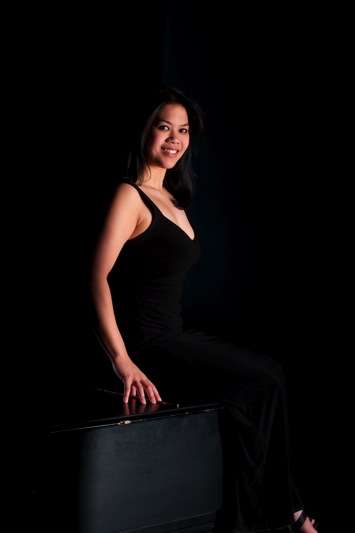|
Back
The Ineffable New York
Weill Recital Hall at Carnegie Hall
04/11/2012 -
Felix Mendelssohn: Fantasy in F Sharp Minor, Op. 28
Christopher Walczak: Dark Blue Etude (World Premiere)
Karl Blench: Delusion (World Premiere)
Claude Debussy: Preludes, Book II: “La Terrasse des audiences du clair de lune”
Heitor Villa-Lobos: Rudêpoema
Ludwig van Beethoven: Fantasy in G Minor, Op. 77 (*)
Ryan Carter: Competing Demands (World Premiere) (*)
Modeste Mussorgsky Pictures at an Exhibition (*)
Andrew Staupe, Alexandria Le (*) (piano)

A. Staupe (© Courtesy of the Artist)
What a curious program this was, performed by two singular pianists, still in their 20’s.
The mainstream composers were represented by the rarest compositions. Three world premieres were given by artists less than 30 years old. And one pianist presented a piece that could technically be the most ferocious ever written.
The two artists were chosen by Pro Musicis, that unique organization which offers more than awards to young musicians Their winners have the duty (or, unquestionably, the pleasure) to give music in hospitals, prisons, Inner City schools and other places rarely reached.
The pair last night, Andrew Staupe and Alexandria Le, are young enough to be continuing their advanced studies, but proficient enough that they are performing around the world. Mr. Staupe and Ms. Le shared this, their first New York concert, and gave sometimes startling indications of their talent.
The first half belonged was Andrew Staupe, whose technical skills were not only impressive but compelled audience members to breathe, at his finish, an audible “Wow!”
He began with yet another Hibernian work by Felix Mendelssohn, a “Scottish Fantasy” Yes, it was composed in Berlin, but the composer had enjoyed his perambulations around jaunts to Scotland, and the opening movements were faintly Scots in character. In the final movement, labeled “Presto”, Mr. Staupe gave the first of many examples of his overpowering technical prowess, This made the usual “presto” dynamics look positively Molto adagio in comparison with his dashing, error-free travels around the keyboard.
Nor did he stop there. Dark Blue Etude by Christopher Walczak was an omnibus showpiece of nuances of jazz (one Gershwin etude was almost quoted in full at the climax) and with a few atonal measures thrown in. But the following Delusion by Karl Blench was obviously composed for Mr. Staupe’s unique talents. It was to be played, said the composer, “as fast as comfortably possible.”
That’s like telling a serial killer to murder “as many as comfortably possible”, for Mr. Staupe treated the keyboard to a non-stop show. He did slow down for a very sensitive Debussy prelude, but that was only a second wind for the Villa-Lobos long but never ever ever lax Rudêpoema.
No translation for Heitor Villa-Lobos’ longest piano piece is possible, but it implies savagery. And Mr. Straube whipped through its challenges–literally!! An insanity of whiplashes, crazy chords, and rhythmic impulses that nobody except a demon could dream up.
Photos of Villa-Lobos, an engaging cigar-smoking boulevardier, gives no indication of the madness within him. And the reality of Mr. Staupe, dressed formally, pleasant, engaging, gave no indication of that “Wow” quality. Whether that translates into more cerebral works only the future can tell.

A. Le (© www.Alexandriale.com)
Alexandria Le, never took up Mr. Staupe’s technical Olympiad, though she was equally adept. Her excellence was in musical painting.
But that came later. Like Mr. Staupe, her opening work was a rarity. I’ve never heard, read or heard of Beethoven’s Fantasia for piano, but it is as unworldly as Liszt’s last atonal pieces. It’s supposed to be in G minor, but that was for convenience. At times, Beethoven wrote wildly out-of-key variations on a most tranquil theme. At times, Ms. Le struck some impulsive scale passages. (and I mean struck!! Forgive the pun, but they were struck Lud and clear!). At other times, Beethoven seemed so free-wheeling that one wonders whether he ever meant this to be played in public.
Her colleague Ryan Carter had composed a piece for this recital which was kind of gimmicky but amiable. The gimmick was the middle pedal of the piano, which retains the sound for certain notes and not others. So Competing Demands challenged Ms. Le to press hard on chords or single notes, playing–almost parenthetically–soft variations on each of the resonating chords.
Finally, Ms. Le came into her own with Pictures At An Exhibition. She did what few other artists think of doing. She actually painted those pictures in sound.
My own score is heavily edited, but Ms. Le did her own free-wheeling redaction on the piano. Not content to “pull” the ox-cart, she retarded measures, jolted others to paint oxen stuck in a pothole. Not content with showing the contrast between the two ghetto Jews, she exaggerated the plutocracy of one and the loquacity of the other. By the time of the Great Gate of Kiev, Ms. Le had given us pictures with the most broad of brushstrokes, the most garish of colors.
Messrs Staupe and Le finished the recital with a Schubert duet, which was engaging, comely and misconstrued.
Rather than leaving with an impression of oh so nice music, one would prefer to have left with impressions of two feverishly talented artists.
Harry Rolnick
|